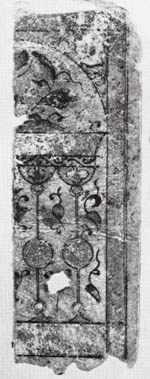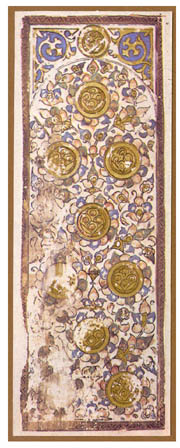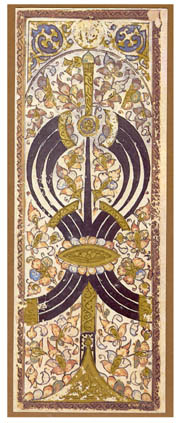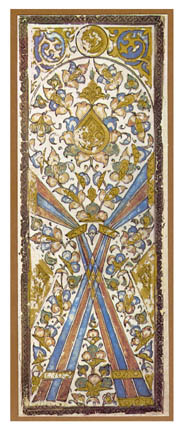|
 MANTEIA does not believe in any of the legends and stories giving an occult origin to the tarot pack,
like the "statement" by Antoine Court de Gebelin in 1781, that the tarot was of Egyptian origin, being
the secret book of the God Thoth. There are other legends still surviving in many esoteric tarot books,
such as that tarot was created at the conference at Fez, Morrocco, where scholars from all over the world
met; there is also the legend, that the gypsies spread tarot in Europe, tarot being one of their secrets.
We don't believe in these legends, since so far no one could come up with convincing evidence as to their
truth. On the other hand, we know that the iconography of the tarot depicts archetypal situations and
scenes, which might have been familiar also to the Egyptians living 4000 thousand years ago, and which
have made them create works of art, expressing the same fundamental ideas as the tarot does.
MANTEIA does not believe in any of the legends and stories giving an occult origin to the tarot pack,
like the "statement" by Antoine Court de Gebelin in 1781, that the tarot was of Egyptian origin, being
the secret book of the God Thoth. There are other legends still surviving in many esoteric tarot books,
such as that tarot was created at the conference at Fez, Morrocco, where scholars from all over the world
met; there is also the legend, that the gypsies spread tarot in Europe, tarot being one of their secrets.
We don't believe in these legends, since so far no one could come up with convincing evidence as to their
truth. On the other hand, we know that the iconography of the tarot depicts archetypal situations and
scenes, which might have been familiar also to the Egyptians living 4000 thousand years ago, and which
have made them create works of art, expressing the same fundamental ideas as the tarot does.
 What we, however do know is, that the earliest European playing cards (and the tarot pack is a pack of
playing cards - even if it has a different structure from the cards we now mostly use for card playing)
date back to 14th century Italy. We do not know exactly what influenced the creation of these packs, some
theories advocate the origin of the playing cards being of Eastern origin. In this article we however
deal with an Islamic pack of cards, The Mamluk cards, which could have influenced the early Italian packs,
and which many recent scholars are convinced it has.
What we, however do know is, that the earliest European playing cards (and the tarot pack is a pack of
playing cards - even if it has a different structure from the cards we now mostly use for card playing)
date back to 14th century Italy. We do not know exactly what influenced the creation of these packs, some
theories advocate the origin of the playing cards being of Eastern origin. In this article we however
deal with an Islamic pack of cards, The Mamluk cards, which could have influenced the early Italian packs,
and which many recent scholars are convinced it has.
 "The Mamluk Playing Cards" were discovered at the Topkapi museum in Istanbul by L.A.Mayer, who in 1939
wrote a treatise on this deck. He describes them as actually being two incomplete sets, some cards rather
different and more crude than the rest, and probably made later to replace missing original cards. The
deck consists - according to Mayer - of five suits: cups, coins, swords, polo sticks and staffs. (Mayer's
statement of the five suits was later questioned by other scholars, and the general opinion is now that
the deck has only four suits). Besides these suits there is one quite different card, showing only a
crescent. Mayer remarks, that this might or might not be the Islamic equivalent of the Joker. Despite
missing cards, Mayer found, that each suit consisted of ten number cards and four court cards, these
being a King, a Governor, a Second-governor, and a Helper. The values were not depicted by illustrations
on the cards, but as a caption at the lower part of the deck. On the basis of the typical decoration it
was possible to confirm these cards as being of Mamluk origin and date the deck to the 15th Century.
"The Mamluk Playing Cards" were discovered at the Topkapi museum in Istanbul by L.A.Mayer, who in 1939
wrote a treatise on this deck. He describes them as actually being two incomplete sets, some cards rather
different and more crude than the rest, and probably made later to replace missing original cards. The
deck consists - according to Mayer - of five suits: cups, coins, swords, polo sticks and staffs. (Mayer's
statement of the five suits was later questioned by other scholars, and the general opinion is now that
the deck has only four suits). Besides these suits there is one quite different card, showing only a
crescent. Mayer remarks, that this might or might not be the Islamic equivalent of the Joker. Despite
missing cards, Mayer found, that each suit consisted of ten number cards and four court cards, these
being a King, a Governor, a Second-governor, and a Helper. The values were not depicted by illustrations
on the cards, but as a caption at the lower part of the deck. On the basis of the typical decoration it
was possible to confirm these cards as being of Mamluk origin and date the deck to the 15th Century.
 Later scholars regarding the Mamluk deck now agree, that Mayer was wrong on several points, a major one
being his assumption that the deck has four court cards. It is now generally agreed that the two cards,
called "The Helper" by Mayer, actually were the missing kings of the appropriate suits. Acknowledging this
makes the deck more complete, transferring the two "Helpers" to be the two missing kings in the same
suits. Also Mayer's suggestion of the joker is clearly wrong, the joker being a fairly recent American
invention.
Later scholars regarding the Mamluk deck now agree, that Mayer was wrong on several points, a major one
being his assumption that the deck has four court cards. It is now generally agreed that the two cards,
called "The Helper" by Mayer, actually were the missing kings of the appropriate suits. Acknowledging this
makes the deck more complete, transferring the two "Helpers" to be the two missing kings in the same
suits. Also Mayer's suggestion of the joker is clearly wrong, the joker being a fairly recent American
invention.
In 1970 another discovery took place. A Collector of Islamic art, Dr. Edmond de Unger, came across papers
from the collection of a Mr. Jean Pozzi. Among the papers was one small piece, that proved to be a
fragment of a small playing card, being a little more than half of the full card. This fragment is from
the suit of cups, and it appears to be the four of cups. The card is remarkably smaller than the Mamluk
cards and the remains of the decoration shows, that it is much simpler and sparser than the former cards.
Despite the fragmentary condition experts in Islamic art were able to date this card of being late 12th
century or early 13th century, and due to details in the decoration, late 12th century seems most likely.
 The Mamluk cards have a great likeness to the early Italian decks of cards; the suitmarks are evidently
identical, and the structure of the Mamluk deck also resembles the ordinary deck of playing cards later
used in Europe. The main theory is therefore that playing cards entered Italy from the Islamic world,
and from Italy spread to other European countries.
The Mamluk cards have a great likeness to the early Italian decks of cards; the suitmarks are evidently
identical, and the structure of the Mamluk deck also resembles the ordinary deck of playing cards later
used in Europe. The main theory is therefore that playing cards entered Italy from the Islamic world,
and from Italy spread to other European countries.
We can call the Mamluk cards a prototype of the European playing card and therefore one of the first
steps leading to the development of the tarot pack, as we know it today. In 1972 a reproduction and
reconstruction pack of the Mamluk cards was published by Aurelia Books of Belgium. Unfortunately the
publisher, Jan Bauwens, was not aware of the corrections to L.A.Mayers assumptions, so the reconstruction
of the pack suffered from such mistakes as having four court cards in each suit. Fortunately, Bauwens did
not take over Mayers suggestions of the pack having five suits. The pack is an excellent reproduction
and the reconstructed cards fit very well with the originals and design.
|